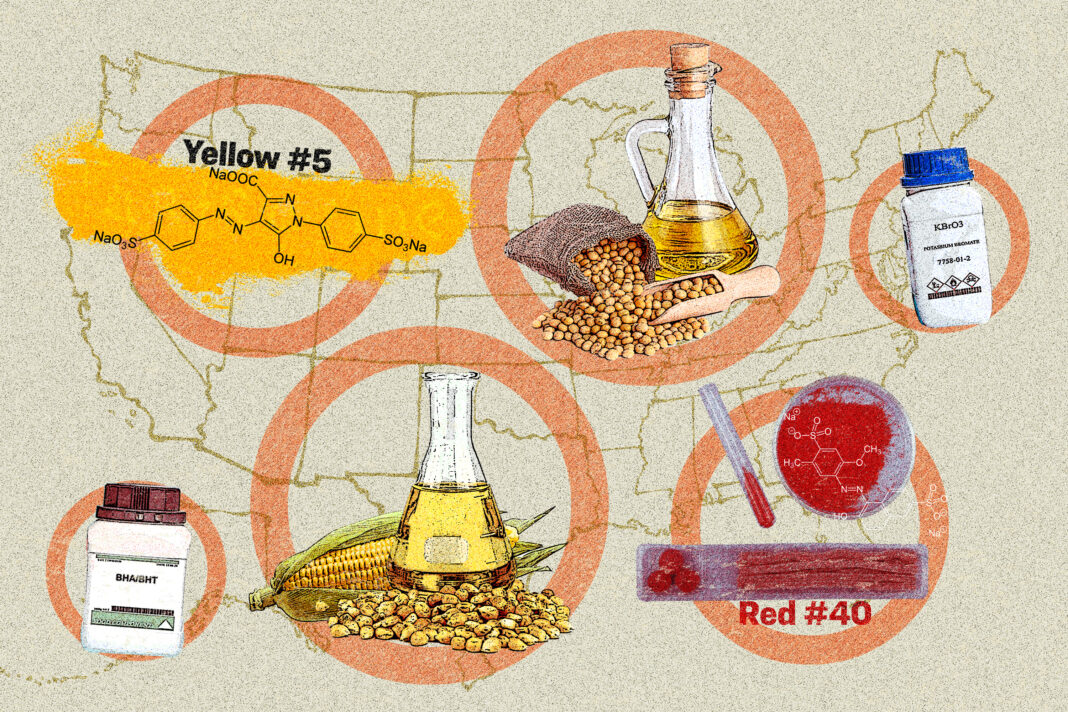|
Getting your Trinity Audio player ready...
|
“Americans are being poisoned,” former presidential candidate Robert F. Kennedy Jr. repeated throughout his campaign. He linked the nation’s poor diet to shorter lifespans and rising health care costs for chronic diseases.
Life expectancy in the United States is five years shorter than that of other developed nations. This may be because 50 to 70 percent of the American diet is ultra-processed foods—the highest consumption rate in the developed world. Many of the food additives and ingredients used in the United States are already restricted or banned in Europe.
Now nominated as secretary of Health and Human Services under the Trump administration, Kennedy will oversee 80 percent of the country’s food supply, as well as all cosmetics, drugs, and pharmaceutical products.
Kennedy has primarily scrutinized several key food ingredients, including high fructose corn syrup, seed oils, and food dye. What is the evidence, and what can he possibly do to exclude them from the American diet?
High Fructose Corn Syrup
During his campaign, Kennedy repeatedly emphasized the risks of high fructose corn syrup (HFCS), the most common sweetener in American processed foods.
Though approved for use in both the EU and the United States, HFCS in Europe is used in a modified form called isoglucose, which contains up to 30 percent fructose, whereas American HFCS has 42 to 55 percent fructose.
HFCS 55, which contains 55 percent fructose, is used most commonly. This more concentrated formula allows food to taste sweeter with a smaller volume of sweetener.
HFCS is similar to table sugar in overall composition, though it went through additional enzymatic processing during production. Research has not shown clear evidence that HFCS is more harmful than sugar, though as a common ingredient in ultra-processed foods, HFCS has undergone a lot of scrutiny.
HFCS is a cheaper ingredient than sugar. Ultra-processed food makers adopted HFCS rapidly in the late 20th century. Between the 1970s and 1990s, HFCS consumption increased by more than 1,000 percent, the greatest change in the American diet over that time. This increase coincided with the emergence and rise of obesity in the 1980s.
Research in rats found that rats that consumed HFCS gained more weight than those that consumed table sugar. Another study in 2012 found that countries that consumed more HFCS had a 20 percent greater prevalence of Type 2 diabetes.
HFCS 55 has a higher fructose content than sugar. This can strain the liver because the liver has to convert fructose to glucose. Therefore excess fructose consumption can lead to buildup in the liver and cause fatty liver disease. Fructose also doesn’t trigger the body to release insulin, nor the hormones that tell the brain to stop eating. Research suggests that this dynamic may lead to overeating and weight gain.
HFCS, like sugar, has also been linked to liver disease, heart disease, and cases of behavioral problems.
HFCS is currently approved by the FDA as Generally Recognized as Safe (GRAS), which means that it underwent a less rigorous approval process by the FDA than products approved as food additives. While the FDA sets an allowable limit for food additives, it does not set one for GRAS substances.
Seed Oils
Kennedy has repeatedly criticized the wide consumption of processed vegetable oils, also called “seed oils.”
During his campaign, he said that seed oils are everywhere and are the most common ingredient in the processed foods that make up the American diet.
Most seed oils, like canola, soybean, corn, and sunflower oils, are approved by the FDA as GRAS. Soybean oil is the most commonly consumed oil in the United States.
These oils are highly processed. They are extracted using a solvent (often hexane, which is toxic). Then they are degummed by adding water and acids to remove the gums of the oil, neutralized with soda to keep the oil from turning rancid, deodorized to make the oil non-pungent, bleached to remove the color, and potentially hydrogenated to keep it shelf-stable, in addition to other processes.
There is currently inconclusive evidence to link seed oils with major health risks, though some studies have suggested a correlation between popular seed oil usage and cancer, according to a previous investigation by The Epoch Times.
This is because, compared to fats like tallow, which is saturated, most processed vegetable oils are high in monounsaturated and polyunsaturated fats, which make them more prone to oxidation when heated. When eaten, these oxidized fats can damage cells and genes in the body.
Seed oils also have a higher omega-6 fatty acid content than omega-3 fatty acids. Research has linked higher omega-6 fatty acid consumption with a whole host of chronic diseases, such as Type 2 diabetes, inflammatory diseases, and more.
Synthetic Food Dyes
Synthetic food dyes, which include tartrazine (yellow 5), red 40, red 2, yellow 6, green 3, blue 1, and blue 2 are not used as prolifically or at all in other countries, Elizabeth Dunford, project consultant for The George Institute for Global Health’s Food Policy Division and adjunct assistant professor at the University of North Carolina, told The Epoch Times.
These food dyes have been linked to cancer and to behavioral problems such as ADHD.
Most food dyes are made from petroleum, which makes them cheaper and more durable than the natural colors used in countries such as Canada and Australia.
In a campaign video released in mid-October, Kennedy specifically targeted tartrazine, used frequently in foods ranging from Doritos to yogurt and supplements such as vitamin gummies and cough syrups.
In Europe, where food coloring is restricted, foods colored with some of these dyes require a label noting they are linked with behavioral problems.
Butylated Hydroxyanisole (BHA) and Butylated Hydroxytoluene (BHT)
Used in chips, crackers, cereals, premade baked goods, and granola bars, BHA and BHT are approved in the United States as GRAS substances.
These chemicals prevent oils from oxidizing. However, unlike antioxidants found in fruits and vegetables, these chemicals affect immunity and are also carcinogenic. Both chemicals are “anticipated to be a human carcinogen” by the National Toxicology Program.
Animal studies have also shown that these chemicals can cause hormone disruptions, and that BHT can lead to liver, thyroid, and kidney problems.
Potassium Bromate
Potassium bromate is added to dough when making bread and baked goods to increase its volume and improve its texture.
Potassium bromate is a possible human carcinogen. In animal studies, it has been shown to cause cancers and blood and liver toxicity.
Since bromate breaks down during the cooking process, one study has suggested that potassium bromate may not cause health problems in humans if the bread it is added to has been properly heated during baking.
Nevertheless, if bromate remains, it can still be problematic.
Other Additives Used in the US That Are Banned in the EU
Besides the food additives Kennedy mentioned during his presidential campaign, there are others he didn’t mention that have come under similar scrutiny.
Titanium Dioxide
Titanium dioxide is approved by the FDA as a color additive and is often used in foods such as salad dressings, bread, and cheese to give products a white appearance.
Titanium dioxide was deemed unacceptable for food products by the European Food Safety Authority (EFSA) in May 2021, because scientists “couldn’t exclude genotoxicity concerns,” Maged Younes, chair of EFSA’s Food Additives and Flavorings Panel, said in an EFSA assessment. Genotoxicity refers to the properties of a chemical that can impair DNA or chromosomes.
Azodicarbonamide (ADA)
Azodicarbonamide (ADA) is most commonly used in plastics and as a bleaching agent in flour-based foods. It is currently approved by the FDA as GRAS.
Animal studies revealed that ADA could be an organ and cellular toxin, while other research demonstrates that it can cause respiratory complications in humans. In another study, researchers found that rats fed a diet containing ADA experienced “significant behavioral changes.”
Benzoyl peroxide
Benzoyl peroxide is most commonly added to flour and milk made for cheeses to bleach the color. It is currently approved by the FDA as GRAS.
The EU banned the use of benzoyl peroxide in food in the 1990s due to concerns about potential toxicity such as liver damage and poisoning.
Benzoyl peroxide can also break down into benzene, a known carcinogen, at temperatures above 122 degrees Fahrenheit. Benzene is classified as a type A carcinogen, meaning that it can cause cancer.
What to Do?
The GRAS system, introduced in 1958, is one of the most criticized aspects of American food regulation.
Food ingredients that are categorized as food additives undergo relatively rigorous premarket safety review, with the FDA setting an allowable limit.
But GRAS ingredients do not have to undergo this premarket review if the substance has a long history of use, or if there is a scientific consensus on safety.
In 1997, the FDA proposed a new regulation that allowed companies to self-determine GRAS status without submitting it for affirmation from the FDA. This change was gradually phased in and made official in 2016. As a result, companies no longer have to notify the FDA when they have a new GRAS substance.
This created a major loophole, with the primary one being that “there are unknown ingredients in the food supply that the FDA and the public doesn’t know about,” Jennifer Pomeranz, associate professor of public health policy and management at NYU School of Global Public Health, told The Epoch Times.
Since this rule was made by the FDA, the FDA can amend the rule to close the loophole, requiring companies to declare what GRAS ingredients they have made. Congress may need to update the 1958 legislation to make it clear that the FDA should review GRAS applications, Pomeranz said.
Europe tends to ban food additives faster than the FDA and requires a rigorous premarket approval process for new ingredients. The FDA is much slower than other countries to make these changes, often 30 years slower or more, Pomeranz said.
If the FDA is able to lower the criteria needed to ban a product, that could allow potentially harmful substances to be taken out of food faster, Pomeranz said. The agency’s criteria for banning a product is also not transparent to the public.
Additionally, there is currently limited evidence linking various food additives with conclusive findings of harm, mostly due to limited research funding.
“The FDA will need more resources in order to review the unbelievable amounts of ingredients we have,” Pomeranz said. These resources would need to come from Congress.
The FDA in September hosted a conference where it mentioned it would do a systematic post-market review of products on the market, with the growing list of GRAS substances as a major focus.
The FDA may not know what to review, though, if food makers do not clearly label what is in their products, Pomeranz said. The new ingredients may be given a vague label of flavoring or preservatives that doesn’t name the actual chemical.
Kennedy mentioned during his campaign that he would get National Institutes of Health, which has an annual research budget of more than $45 billion, to fund research on the causes of chronic disease. This would include finding the health and safety risks of various food chemicals.
Pomeranz said this would be a welcome change.
Some large industry groups have publicly expressed their support of more rigorous food regulation, Pomeranz said.
According to her, companies that give consumers safe and nutritious food are currently at a disadvantage.
“It’s really hurting competition to allow companies that are not doing right to just get into the marketplace,” she said. “If there’s no regulation to even the playing field, companies have less incentive to protect us, right?”





